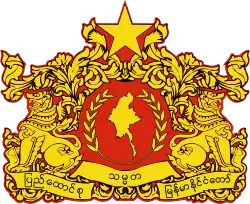National Defence and Security Council
The National Defence and Security Council (Burmese: အမျိုးသား ကာကွယ်ရေးနှင့် လုံခြုံရေး ကောင်စီ, Burmese pronunciation: [əmjóðá kàkwɛ̀jé n̥ḭɴ lòʊɴdʑòʊɴjé kàʊɴsì]; abbreviated NDSC) is an eleven-member national security council responsible for security and defence affairs in Myanmar. Though the president is the chief executive of the government of Myanmar, the 2008 Constitution reserves certain important executive powers for the NDSC and certain actions of the president require approval by the NDSC. Of the 11 members, the commander-in-chief appoints 5 members and controls 6 votes, guaranteeing the Tatmadaw (military) permanent control of a key part of the executive branch regardless of election results.[1][2][3] The military reports directly reports to NDSC, effectively making the military unaccountable.[4] The NDSC's existence is enshrined in Chapter V of the Constitution of Myanmar,[5] and it was formed on 31 March 2011.[6][1]
| အမျိုးသား ကာကွယ်ရေးနှင့် လုံခြုံရေး ကောင်စီ [əmjóðá kàkwɛ̀jé n̥ḭɴ lòʊɴdʑòʊɴjé kàʊɴsì] | |
| Agency overview | |
|---|---|
| Formed | 31 March 2011 |
| Type | National security council |
| Jurisdiction | Government of Myanmar |
| Headquarters | Naypyidaw |
| Agency executive |
|
 |
|---|
|
|
After President Win Myint refused to call a meeting of the NDSC to address the Tatmadaw’s baseless allegations of massive voter fraud in the 2020 general election, the military under the leadership of Commander-in-Chief Min Aung Hlaing executed a coup on 1 February 2021, removing Win Myint and installing Myint Swe as Acting President so he could call a meeting of the NDSC and transfer state power to Min Aung Hlaing. The NDSC has since continued to serve as the purported basis of legitimacy for Min Aung Hlaing’s military dictatorship.[7]
The NDSC's constitutionally enshrined roles include expansive powers:
- Recommend pardonees for the President to grant amnesty[5][8]
- Approve the President's act of severing foreign diplomatic relations[5]
- Coordinate with the President to take military action against aggressors[5]
- Approve the Tatmadaw's ability to conscript citizens[5]
- Nominate a candidate for Commander-in-Chief of Defence Services, to be appointed by the president[5]
- Coordinate with the President in declaring a state of emergency[5]
- Exercise legislative, executive and judiciary powers during a state of emergency[5]
- Exercise sovereign power during a state of emergency[5]
Members
According to the Constitution, NDSC's membership must consist of the following individuals:
National Defence and Security Council of Myint Swe (2021–present)
| Position | Name |
|---|---|
| Acting President and First Vice President | Myint Swe |
| Second Vice President | Henry Van Thio |
| Speaker of the House of Representatives | T Khun Myat |
| Speaker of the House of Nationalities | Vacant |
| Commander-in-Chief of Defence Services | Min Aung Hlaing |
| Deputy Commander-in-Chief of Defence Services | Soe Win |
| Minister of Defence | Mya Tun Oo (2021–2023) |
| Tin Aung San (2023–present) | |
| Minister of Home Affairs | Soe Htut (2021–2023) |
| Yar Pyae (2023–present) | |
| Minister of Foreign Affairs | Wunna Maung Lwin (2021–2023) |
| Than Swe (2023–present) | |
| Minister of Border Affairs | Tun Tun Naung |
National Defence and Security Council of Win Myint (2018–2021)
National Defence and Security Council of Htin Kyaw (2016–2018)
National Defence and Security Council of Thein Sein (2011–2016)
As of 9 July 2013, NDSC was composed of the following members:[9][10][11]
| Position | Name |
|---|---|
| President | Thein Sein |
| First Vice President | Tin Aung Myint Oo(2011–2012) |
| Sai Mauk Kham(2012–2016) | |
| Second Vice President | Sai Mauk Kham(2011–2012) |
| Nyan Tun(2012–2016) | |
| Speaker of the Pyithu Hluttaw | Shwe Mann |
| Speaker of the Amyotha Hluttaw | Khin Aung Myint |
| Armed Forces Commander-in-Chief | Min Aung Hlaing |
| Armed Forces Deputy Commander-in-Chief | Soe Win |
| Minister of Defence | Hla Min(2011–2012) |
| Wai Lwin(2012–2015) | |
| Sein Win(2015–2016) | |
| Minister of Home Affairs | Ko Ko |
| Minister of Foreign Affairs | Wunna Maung Lwin |
| Minister of Border Affairs | Thein Htay (2011–2013) |
| Thet Naing Win(2013–2015) | |
| Kyaw Swe(2015–2016) |
References
- Htun Aung Gyaw (21 February 2014). "Myanmar's constitutional crisis reaching boiling point". The Nation. Retrieved 27 June 2015.
- Sithu Aung Myint (20 May 2015). "Coalition government: just a fantasy?". Myanmar Times. Retrieved 27 June 2015.
- MacDonald, Adam P (1 May 2013). "The Tatmadaw's new position in Myanmar politics". East Asia Forum. Retrieved 27 June 2015.
- Weiss, Stanley A (4 March 2013). "Myanmar: A nation at war with itself". Myanmar Times. Retrieved 27 June 2015.
- "Constitution of the Republic of the Union of Myanmar" (PDF). Ministry of Information. September 2008. Retrieved 27 June 2015.
- "Myanmar forms national defense, security council". People's Daily. 1 April 2011. Retrieved 27 June 2015.
- Noel, Thibaut (March 2022). "Unconstitutionality of the 2021 Coup in Myanmar" (PDF). International Institute for Democracy and Electoral Assistance. Retrieved 15 March 2023.
- Soe Than Lynn (24 October 2011). "More amnesties planned, says Thura U Shwe Mann". Myanmar Times. Retrieved 27 June 2015.
- "National Defense and Security Council (NDSC)". Alternative Asean Network on Burma. 9 July 2013. Retrieved 27 June 2015.
- "အမျိုးသားကာကွယ်ရေးနှင့် လုံခြုံရေးကောင်စီဖွဲ့စည်းခြင်း (ကြေညာချက်အမှတ် ၉/၂ဝ၁၁)". နိုင်ငံတော်သမ္မတရုံး. 6 April 2011.
- "အမျိုးသားကာကွယ်ရေးနှင့် လုံခြုံရေးကောင်စီတွင် အဖွဲ့ဝင် ပြင်ဆင်ဖွဲ့စည်းခြင်း (ကြေညာချက်အမှတ် ၃/၂၀၁၂)". နိုင်ငံတော်သမ္မတရုံး. 16 August 2012.